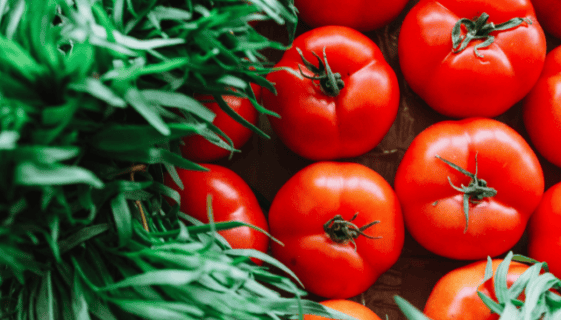Stuffed bell peppers are not only a delicious and versatile dish but a nutritionally balanced meal and provide the ideal ratio of vegetables, lean protein, and complex carbohydrates. Bell peppers, mainly the red, yellow, and orange varieties, are rich in antioxidants like vitamin C and beta-carotene, which help combat oxidative stress and reduce inflammation in the body. They also contain quercetin, a flavonoid known for its anti-inflammatory properties. This makes bell peppers an excellent choice for those looking to enhance their diet with anti-inflammatory foods. By stuffing them with a wholesome mix of lean proteins, whole grains, and flavorful, aromatic vegetables, you create a nutrient-dense meal that’s as beneficial for your health as it is delightful to your taste buds.
– Melanya Kushla, MS, RD, CHES at Taste & Thrive LLC
Stuffed Bell Peppers
Yield: 4 servings
Serving Size: 1 stuffed bell pepper
Ingredients
¼ cup uncooked brown or wild rice
1 Tablespoon olive oil
¼ cup of diced onion
2 cloves garlic, minced
¾ cup lean ground turkey breast, tofu crumbles, or black beans
¼ teaspoon ground black pepper
1 teaspoon Italian seasoning
⅛ teaspoon salt
1 roma tomato, diced
½ cup diced mushrooms
4 bell peppers
Optional Garnish: ¼ cup parmesan cheese, non-dairy cheese, or nutritional yeast
Utensils
small pot with lid, large skillet, mixing spoon, cutting board, chef’s knife, spoon, measuring cups and spoons, 8×8” glass baking dish
Directions
- Preheat the oven to 400°F.
- Prepare the rice or other grain of choice in a small pot according to package directions.
- While the rice is cooking, dice up the tomato and mushrooms. Set aside.
- After the rice is cooked, remove it from the heat and set aside. Keep the lid on until ready to mix in.
- Place a large skillet over medium-high heat. Add the olive oil, onions, and garlic, and saute for 5-8 minutes until the onions are soft and translucent.
- Then, add your choice of protein (lean ground turkey, tofu crumbles, or black beans). Stir and cook for 5-8 minutes until your protein is cooked through and thoroughly blended with the aromatic vegetables.
- Next, add the ground black pepper, Italian seasoning, salt, diced tomatoes, and mushrooms. Cook for 5-8 minutes until the mixture is moist but not runny with extra liquid.
- Add in the rice and turn off the heat. Stir and prepare to stuff the peppers.
- Carefully take each bell pepper and cut a hole out in the top, around the stem. Remove the stem and attached seeds.
- Using a spoon, carefully stuff each bell pepper with the cooked mixture and place the peppers open-side up in a greased 8×8” glass baking dish.
- Garnish the top of each pepper with a Tablespoon of freshly grated parmesan cheese, non-dairy cheese, or nutritional yeast.
- Bake, covered with aluminum foil, for 20 minutes. Remove from the oven, allow to cool slightly, and enjoy!
Nutrition Info
(Per Serving)
225 calories – 6.5g fat – 1.5g sat fat – 35g carbohydrates – 10g protein – 4g fiber – 219mg sodium
Nutrition Highlights
Food is both a joy in life and physical nourishment. Our recipes are carefully created with anti-inflammatory ingredients in flavorful combinations and cooking methods so you can both take care of your body and enjoy doing so!
- Brown or Wild Rice are high-protein whole grains. It is packed full of fiber to help promote healthy gut microbes, support a robust immune system, and reduce inflammation. They promote satiety and have been linked to increased longevity. The polyphenols in them also have high antioxidant activity.
- Garlic and Onion are celebrated for their culinary and medicinal properties, primarily due to their active compound allicin, which has been shown to lower blood pressure and cholesterol levels, reducing the risk of heart disease. It has potent antibacterial and antiviral properties, helping to fight infections. They also contain antioxidants that protect against cell damage and aging. It may improve bone health by increasing estrogen levels in females and supporting detoxification processes in the liver.
- Ground Turkey or Chicken: A great source of lean protein rich in other vital nutrients to help us maintain strong bones. It also supplies tryptophan, shown to help relieve stress, and does not have the pro-inflammatory compounds found in red meats, such as beef or pork.
- Culinary Herbs, such as those found in Italian seasonings, such as basil, oregano, parsley, rosemary, and thyme, are packed with vitamins, minerals, and antioxidants, offering various health benefits. They contain volatile oils and polyphenol compounds with anti-inflammatory, anti-bacterial, and antiviral properties. Herbs can support heart health, improve digestion, and may protect against chronic diseases, including cancer. They are also a rich source of vitamins A, C, and K, essential for vision, immune function, and blood clotting.
- Tomatoes: A great source of lycopene that helps reduce the risk of cancer and heart disease and protect skin integrity. Cooking tomatoes in healthy fat increases the amount of available lycopene the body will absorb.
- Mushrooms: Make sure to cook your mushrooms to increase digestibility and degrade a possible toxic compound found in raw mushrooms. Mushrooms are an excellent source of dietary fiber (beta-glucan) and one of the only foods that can store vitamin D when sun exposure. They contain anti-inflammatory, cancer-fighting, and immune-boosting properties and are rich in minerals such as selenium (an antioxidant), which help develop a savory flavor profile in dishes.
- Bell Peppers: All colors of bell peppers are from the same plant. A bell pepper starts green and, as it ripens, it will become yellow, then orange, red, or purple, depending on the variety. As the bell pepper ripens, there is also an increase in the nutrient concentration, with orange and red having the highest. Bell peppers have high amounts of antioxidants called carotenoids that help protect cells from oxidative damage.
⭐️ FREE DIET KICKSTART
During this 7-day challenge, you’ll receive daily emails packed with doctor-recommended information, delicious recipes, and expert tips. Each day will focus on a specific aspect of dietary wellness, empowering you to make sustainable changes that combat inflammation and promote overall well-being. JOIN NOW
A Word on Sausage and Other Processed Meats
Many stuffed bell pepper recipes are made with browned and crumbled sausage, which in most forms is not an ideal food for cancer prevention, treatment, or survivorship. The types of sausage that people typically find are pre-made links, patties, or crumbles and are considered processed meat products. Processed meats are considered a detriment to our health. Consumption of them is discouraged due to the high saturated fat and sodium and carcinogenic preservatives, such as sodium nitrate. However, sausage does not have to be processed; fresh sausage can also be found or made with plain ground meat, such as ground turkey or chicken. These types of sausage are minimally processed and are perfectly fine to consume as part of a balanced diet, as they can be prepared at home or purchased without added salt, made from a lean protein such as chicken or turkey, and free from preservatives. When shopping, look for fresh sausage in the butcher section of the grocery store or make your own – take a pound of raw ground chicken or turkey and mix about 3 Tablespoons of your favorite spice and herb blend. Viola – you now have a fresh, homemade sausage to add to stuffed bell peppers, lasagna, soups, and whatever else your heart desires!
LEARN MORE: How to Choose and Safely Grill Meat
Cooking Temperatures
If you choose to eat and cook with ground meat, such as ground chicken or turkey, take extra care to ensure your meat is cooked thoroughly to reduce the risk of foodborne illness. Several different types of pathogens, or harmful bacteria, live on the surface of raw meat, fish, and eggs, and grinding the meat increases the surface area- thus, it spreads the bacteria around more. This is why we cook meat, poultry, fish, and eggs- to kill the bacteria and reduce them to a safe level for us to consume. If you choose an alternative protein source, such as tofu crumbles or black beans, cooking to a minimum internal temperature is unnecessary, as these foods do not harbor such bacteria.
- Minimum internal temperature. All animal-based proteins have a minimum internal temperature for cooking to ensure the food is safe from harmful bacteria. For poultry, such as chicken or turkey, that minimum temperature is 165 °F. If you are concerned about undercooking, a simple thermometer can be picked up at the store for ~$5 and used to take the temperature of your food.
- If you are currently undergoing any form of treatment for cancer, such as chemotherapy, radiation, or surgery, I recommend practicing extra precaution when cooking and ensuring your food is cooked to the minimum internal temperatures to reduce your risk of contracting a foodborne illness while your body’s immune system is vulnerable.
WANT MORE? See all of our delicious, anti-inflammatory recipes here!



 Melanya Kushla
Melanya Kushla 

